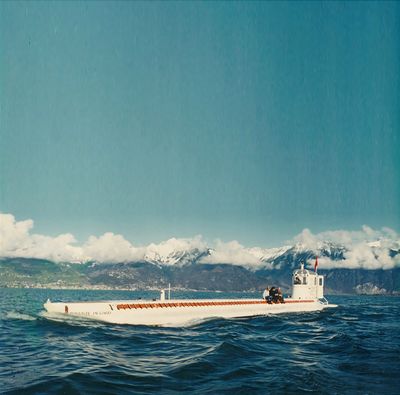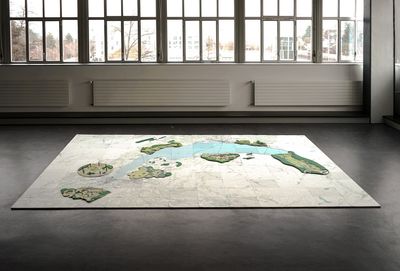Metropolitan Countryside
Lac Léman
European territory has become completely urbanised. The countrysides in the traditional sense have disappeared; the distinctions between the town and the country have been blurred. In contrast to the unambiguous urban transformations of cities, the processes of urban change in the countryside are massive, yet often unnoticed. Away from the public eye and professional scrutiny, these processes have created new urban identities and configurations in the formerly rural realm of Europe. The studio series European Countryside will explore the terra incognita of the countryside, and its radical mutations. The project aims to reinvent the contemporary countryside as a legitimate and critical subject of the discipline of architecture.
Lac Léman and its urbanised areas—extending from the lakesides into the Rhône valley and up the slopes of the Jura and Alps—will serve as the blueprint for the investigation of the Metropolitan Countryside. This is a territory where metropolitan life is embedded within the scenic landscapes of agricultural land and nature: the lake, vineyards and mountain slopes are not just a scenic urban backstage, but the key ingredients of the metropolis. The two poles of the “Léman City”, Geneva and Lausanne, define one of the most desirable international metropolises in the world. Its appeal to international institutions and businesses—and its high quality of life—can be directly attributed to the unique, countryside-like attributes of its urban landscape. Intrigued by this productive contradiction, Architecture of Territory initiates a two-semester project on Lac Léman. During the autumn of 2016, we will focus on the concept of Metropolitan Countryside, investigating the possibilities of bringing the countryside and the metropolis closer together: What are the benefits and potentials of agricultural land and nature for the contemporary metropolis? What are the new concepts of urban living, beyond “the city”, in the extended metropolitan setting?
The metropolis and the countryside are typically understood as relatively distinct and incompatible forms of territorial organisation. But, there is also strong affinity between the two categories, and the case of Lac Léman offers surprising evidence for it. Here, the metropolis and the countryside have mixed together in unexpected ways: Lakeside vineyards have become the destinations of international elites; former villages overlooking the lake host global enterprises and headquarters; nature areas serve as metropolitan playgrounds, and, at higher altitudes, remote hamlets attached to transportation lines function as migrant worker neighbourhoods. The lake in the centre and the mountain peaks in the distance, form an inner and an outer urban horizon, and continue to supply boundless landscape imaginaries to the Léman City. At the same time, the presence of the Franco-Swiss border generates uneven development in the territory. The Lac Léman metropolitan region accounts for nearly one third of Switzerland’s cross-border workers, the frontaliers. The growing working population results in uneven patterns of urban living, usually expanding into agricultural land.
The urban networks encircling Lac Léman and the carefully staged, seemingly rural landscapes extending out from the lakeshores, can be experienced as “metropolitan countryside”: a seeming oxymoron, a unique and exciting situation. This is a new kind of territory, where urban living develops in the formerly rural land, through gradual transformation. The countryside-like qualities of low urban density, the presence of cultural landscapes and of nature areas, continues to supply value and identity to the Léman City.
In the panorama of European countrysides, the ambiguous case of Lac Léman will serve as a model for the study of the role of countryside for the 21st century metropolis. The semester will concentrate on researching and designing new patterns of urban living in the transnational Lac Léman setting. We will explore the potentials of cultural landscape, agriculture and nature as integral parts of a broad urban program—the key ingredients of the metropolis. Based on the Lac Léman case, we will describe metropolitan countryside as paradigmatic urban concept, a model for the European territory.
Students will work in groups of two. All projects will compose a common vision for Lac Léman. The work will be represented in the form of drawings, physical models and a book. All projects will be made public on Architecture of Territory website.
Investigative journey constitutes the core of the project. Travelling through the territory, we will experience its complexity and beauty. The field research will be organised in form of several group and individual excursions. The mandatory group trip will take place from 8-12 October 2016. Students who have obligatory courses on Monday, October 10, are required to organise their substitution or dispensation, in order to enrol. Additional 2-3 day individual trip to the research site will be required, and planned with the teaching team depending on the project task. Cost frame B.
The project will benefit from exchange with the EPFL Atelier Alps, led by Prof. Paola Vigàno and the Accademia di Architettura di Mendrisio, territorial studio conducted by Prof. Frédéric Bonnet. The collaborative exchange of the three schools is initiated and supported by the Geneva based Fondation Baillard, with the goal to explore potentials of densification of the Swiss territory. The collaboration will result in a common exhibition and a book in the end of 2017.
The project on Lac Léman will extend over two semesters, HS 2016 and FS 2017. The students are invited to join one of the two semesters.
Architecture of Territory is looking for avid travellers and team workers with high motivation and independent position.



